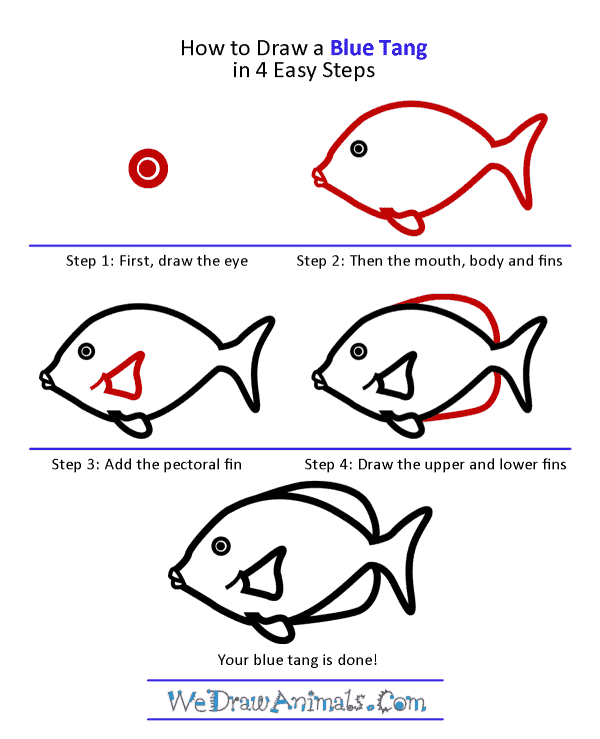In this quick tutorial you'll learn how to draw a Blue Tang in 4 easy steps - great for kids and novice artists.
The images above represent how your finished drawing is going to look and the steps involved.
Below are the individual steps - you can click on each one for a High Resolution printable PDF version.
At the bottom you can read some interesting facts about the Blue Tang.
Make sure you also check out any of the hundreds of drawing tutorials grouped by category.
How to Draw a Blue Tang - Step-by-Step Tutorial
Step 1: Draw a circle with a dot in it for the eye.
Step 2: Draw two big curves around the eye that meet at pointed ends. Add two small curves for lips on one end and a curved triangle on the other end for the tail. Draw a curve on the bottom of the body.
Step 3: Add a curve that attaches to a triangle under the eye.
Step 4: Add two curves that go from the middle of the body to the tail. You did it! You can color it with a yellow tail and a yellow spot on the fin, with black patterns along the back, and the rest blue. These fish mostly eat plankton. Dory from Finding Nemo is a blue tang! Blue tang are mostly used by humans as bait for other fish or pets, but they do not do well in captivity and are important to the health of the coral reef, so many environmentalists are against keeping them.
Interesting Facts about Blue Tangs
Blue Tangs are coral reef fish in the Atlantic Ocean. They grow to about 16 inches and start out in life as yellow. As the fish grow older they develop a bright shade of blue. Blue Tangs are found near the coasts of Florida and the Bahamas. Groups have also been found north of New York and near Brazil. Their food is algae and in some places they eat krill, which is a small crustacean. In the coral reefs a Blue Tang is known to be a “cleaner fish.” Cleaner fish are fish that eat the algae and other things like dead skin and parasites off larger fish. These fish are very helpful in preventing disease and other health issues in other fish.
Did you know?
- There are 3 behaviors a Blue Tang is known for: territorial, schooling, and wandering. A territorial Blue Tang is often alone and is defending where it calls home. Home for a Blue Tang includes all the rocks, sand, and food in the area. When a Blue Tang is in territorial mode it is very aggressive. In the schooling stage, Blue Tangs travel in groups. They often mate during this stage and split off from the school to release eggs. A wandering Blue Tang doesn’t pay much attention to anything. They swim around the reef just trying to stay out of other fish’s way.
- Blue Tangs are cleaner fish, but they also visit other “cleaning stations” to have smaller fish clean them. When they are ready to be cleaned, they pose in a head stand.
- When a Blue Tang is hurt, they will visit a cleaning station, because the fish will eat the dead tissue in the wound. It makes the wound heal faster.
- Blue Tang eggs hatch after 24 hours or 1 day!
- 1 of 75 species of Surgeonfish.
Lesson Plan Note: Draw two Blue Tang fish side by side. Make copies and distribute it to the students. Set out crayons, markers, and colored pencils, then ask the students to color one Tang in its juvenile colors and the second in its adult colors.





